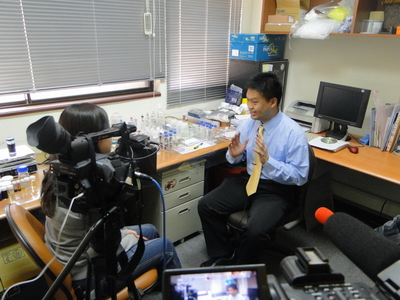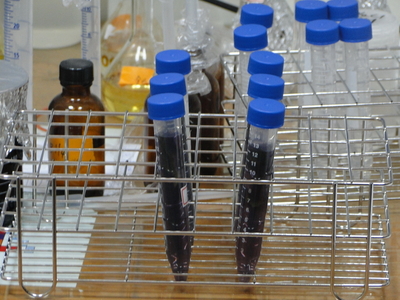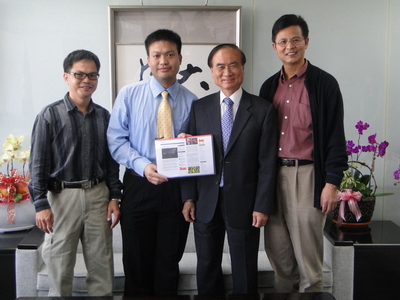Former NCKU Doctoral Student’s Discovery of Gold Nanoparticles to Induce Luminescence in Leaves Attracts Foreign Media’s Attention



Tainan, Taiwan, November 30th, 2010
Post-doctor Yen-Hsun Su of Research Center for Applied Science (RCAS), Academia Sinica, Taiwan, a former student of Department of Physics at National Cheng Kung University (NCKU), has been interviewed by reporters from Thomson Reuters in the laboratory of his supervising teacher Prof. Wei-Min Zhang, because of his discovery that gold nanoparticles can induce luminescence in leaves.
As this discovery has captured the attention of foreign media, Dr. Yen-Hsun Su has been interviewed consecutively by the academic magazine Chemistry World and another international scientific magazine New Scientist a while ago, and recently by reporters from the internationally renowned news service provider Reuters.
“Since our Editor from Washington, United States, noticed the news article about the discovery and believed that foreign media will find this topic fresh and interesting and that the recorded clip can illustrate the future potential of the development of the discovery, we were asked to come to National Cheng Kung University to video interview Dr. Yen-Hsun Su,” said the reporters when they introduced themselves.
During the interview, the reporters raised questions from the three perspectives of concept, origin and future development potential of the discovery and also recorded the step-by-step experiment process, from preparing chemicals, testing equipments to injecting into test tubes.
Noteworthy to mention, when he is informed of the news, NCKU President Michael Ming-Chaio Lai has spared time to meet Dr. Yen-Hsun Su and the reporters from Thomson Reuters in the Office of the President, encouraged Dr. Su to continue the research and integrate gene theories to create a method that can allow leaves to glow naturally as the seeds grow into trees, and urged students to make use of their imagination to stimulate new ideas and creativities.
Dr. Yen-Hsun Su mentioned, “Nowadays, many light emitting diode (LED), especially white light emitting diode, uses phosphor powder to stimulate light of different wavelengths. However, phosphor powder is highly toxic and its price is expensive. As a result, I had the idea to discover a method which is less toxic to replace phosphor powder which can harm human bodies and cause environmental pollution. In addition, because the nanoparticles can only reach cytoplasm rather than the nucleus at the current stage, it still requires many years of research to reach the goal that President Lai has hoped, which is for trees to replace street lights, absorbing carbon dioxide while engaging in photosynthesis.”
In his research, by implanting the gold nanoparticles into Bacopa caroliniana plants, Dr. Yen-Hsun Su was able to induce the chlorophyll in the leaves to produce a red emission. Under high wavelength of ultraviolet, the gold nanoparticles can produce a blue-violet fluorescence to trigger a red emission of the surrounding chlorophyll.
In the future, bio-LED could be used to make roadside trees luminescent at night, but technologies and bioluminescence efficiency need to be improved for the trees to replace street lights and reach the goal of energy saving and environmental protection.
Post-doctor Yen-Hsun Su of Research Center for Applied Science (RCAS), Academia Sinica, Taiwan, a former student of Department of Physics at National Cheng Kung University (NCKU), has been interviewed by reporters from Thomson Reuters in the laboratory of his supervising teacher Prof. Wei-Min Zhang, because of his discovery that gold nanoparticles can induce luminescence in leaves.
As this discovery has captured the attention of foreign media, Dr. Yen-Hsun Su has been interviewed consecutively by the academic magazine Chemistry World and another international scientific magazine New Scientist a while ago, and recently by reporters from the internationally renowned news service provider Reuters.
“Since our Editor from Washington, United States, noticed the news article about the discovery and believed that foreign media will find this topic fresh and interesting and that the recorded clip can illustrate the future potential of the development of the discovery, we were asked to come to National Cheng Kung University to video interview Dr. Yen-Hsun Su,” said the reporters when they introduced themselves.
During the interview, the reporters raised questions from the three perspectives of concept, origin and future development potential of the discovery and also recorded the step-by-step experiment process, from preparing chemicals, testing equipments to injecting into test tubes.
Noteworthy to mention, when he is informed of the news, NCKU President Michael Ming-Chaio Lai has spared time to meet Dr. Yen-Hsun Su and the reporters from Thomson Reuters in the Office of the President, encouraged Dr. Su to continue the research and integrate gene theories to create a method that can allow leaves to glow naturally as the seeds grow into trees, and urged students to make use of their imagination to stimulate new ideas and creativities.
Dr. Yen-Hsun Su mentioned, “Nowadays, many light emitting diode (LED), especially white light emitting diode, uses phosphor powder to stimulate light of different wavelengths. However, phosphor powder is highly toxic and its price is expensive. As a result, I had the idea to discover a method which is less toxic to replace phosphor powder which can harm human bodies and cause environmental pollution. In addition, because the nanoparticles can only reach cytoplasm rather than the nucleus at the current stage, it still requires many years of research to reach the goal that President Lai has hoped, which is for trees to replace street lights, absorbing carbon dioxide while engaging in photosynthesis.”
In his research, by implanting the gold nanoparticles into Bacopa caroliniana plants, Dr. Yen-Hsun Su was able to induce the chlorophyll in the leaves to produce a red emission. Under high wavelength of ultraviolet, the gold nanoparticles can produce a blue-violet fluorescence to trigger a red emission of the surrounding chlorophyll.
In the future, bio-LED could be used to make roadside trees luminescent at night, but technologies and bioluminescence efficiency need to be improved for the trees to replace street lights and reach the goal of energy saving and environmental protection.
Provider:
新聞中心
Date:
99-11-30